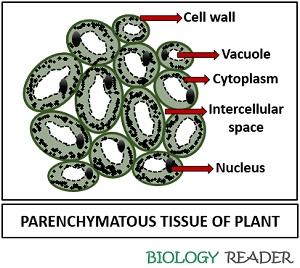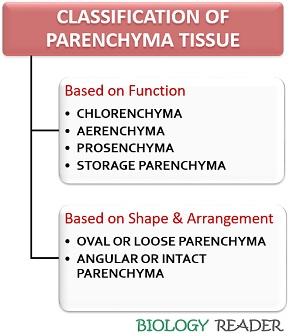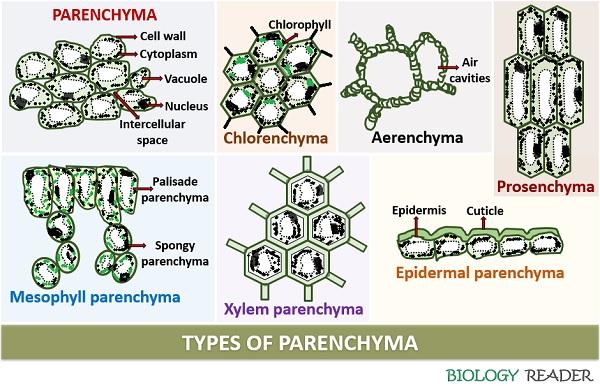Parenchyma in plants is the types of simple permanent tissue that possesses some ideal properties that discriminate it from the other cells.
Cell division: Parenchyma tissues cannot undergo cell division.
Vacuole: They comprises a large vacuole.
Nature: Structurally and physically, parenchyma is a kind of unspecialised tissue.
Modification: Parenchyma modifies itself to perform diverse functions in plant cells.
When the parenchymatous cells appear in aggregates, they carry a polygonal shape by having 14-sided polyhedral cells. Parenchyma cells also occur in other forms like spherical, elongated, and stellate.
In this context, we will learn the definition, types (based on function, shape and arrangement), characteristics, structure and functions of the parenchyma tissue.
Content: Parenchyma in Plants
Definition of Parenchyma Tissue
It merely refers to the simple permanent tissue, which appears thin-walled and serves as a “ground tissue” by forming a packaging material of all the non-woody structures like leaves, roots and stems. The term parenchyma was originated from the Greek term “Para” (beside) and “Enchyma” (inclusion). It is supposed to be introduced during the 17th century when Robert Hooke discovered the plant cells.

Parenchyma tissue is a type of non-vascular tissue composed of simple, living and undifferentiated cells. A parenchymatous tissue modifies into three major types, namely chlorenchyma, aerenchyma and prosenchyma.
Types of Parenchyma Tissue
Parenchyma tissues in plants are classified based on their functions, shape, arrangement.

Based on Functions
There are four significant kinds of parenchymatous tissues, depending upon their function within the plant cells:
- Chlorenchyma: It refers to the parenchymatous cell that possesses chloroplast. Thus, it assimilates the chlorophyll pigments and termed “Assimilatory parenchyma”. In leaves, it differentiates into mesophyll cell that has two distinct parenchymatous cells (palisade and spongy). It is present in the mesophyll zone of the leaves, sepals and phyllodes.
Function: Participates in photosynthesis. - Aerenchyma: It refers to the parenchymatous cell that comprises large air-filled intercellular spaces and is termed “Air storing parenchyma”. Aerenchyma cells are prevalently present in the roots, stems and leaves of hydrophytes. It comprises a few large-sized air cavities between the parenchymatous cells to perform various functions.
Function: Participates in gaseous exchange and maintains the buoyancy of hydrophytes. - Prosenchyma: It refers to the parenchymatous tissue that possesses elongated cells with a thickened wall. The prosenchyma appears spindle-shaped with tapering ends.
Function: Promotes rigidity to a plant. - Storage parenchyma: It refers to the parenchymatous tissue that contains large-sized vacuolated cells. It stores water, minerals, sugar, protein granules, oil droplets etc. The cell wall of storage parenchyma is generally thick because of hemicellulose deposition.
Function: Helps in the storage of food. - Xylem parenchyma: This kind of parenchymatous cells possess a small size and a thick cell wall.
Function: Facilitates water and mineral conduction. - Phloem parenchyma: This kind of parenchymatous cells have elongated cells and a thin cell wall.
Function: Facilitates conduction of food prepared by the leaves. - Epidermis parenchyma: This kind of parenchymatous cells are elongated with zero intercellular space. Epidermis parenchyma possesses a cutinized cell wall or cuticle enclosing a single-layered epidermis.
Function: Protects the plant in counter to environmental stress.
Based on Shape and Arrangement
There are two types of parenchymatous tissues, depending on the shape and arrangement:
- Oval or loose parenchyma: Here, the parenchymatous cells appear irregular, loosely arranged, oval-shaped with more intercellular space. It is present in the inner cortex of the stem.
- Angular or intact parenchyma: They appear polygonal-shaped and have intact cell arrangement with small or no intercellular space. It is present in the outer cortex of the root.
Characteristics of Parenchyma in Plants
Parenchyma cells share many important features based on their cell morphology and physiology.
- Shape: They exhibit polygonal shape when the cells lie close to each other and sometimes possess oval or spherical shape.
- Symmetry: Parenchyma possesses an isodiametric symmetry.
- Cell-wall: The cell wall of parenchyma is usually thin and formed primarily of cellulose.
- Nature: It behaves like a living cell.
- Occurrence: Predominates in the smoother parts of leaves, stems and roots.
- Constitution: Parenchyma tissues are the most usual and abundant tissues that constitute most of the plant’s part.
- Vacuoles: A parenchyma cell comprises a large-sized central vacuole.
- Functions: Parenchyma cell performs a functional role in food storage and plant’s protection.
Distribution
Parenchyma tissues are distributed in the plants following parts:
- Pith and cortex region of stem and root.
- Mesophyll cells of the leaves.
- The flesh of succulent roots.
- The endosperm of seeds etc.
Arrangement
- Parenchyma cells firmly intact with each other without any intercellular space on maturity. Example: Endosperm tissue of seeds.
- Some parenchyma cells comprise a more intercellular space and have loosely arranged neighbouring cells. Example: Stems and leaves of the hydrophilic plants.
Structure of Parenchyma Tissue
A structure of parenchyma tissue includes:
- Aggregates of numerous polygonal or spherical parenchyma cells with a living protoplast.
- A large central vacuole.
- Peripheral cytoplasm incorporated with a nucleus, which can be one or sometimes more in number.
It is the most abundant and common tissue of the plants where the cells have a compact or loose arrangement with little, large or no intercellular space. A parenchyma cell may also contain tannins or some resinous materials. Plasmodesmata join the cells of parenchyma tissues. The cell sap of parenchyma generally stores food sources like carbohydrates, fats, oils droplets, protein granules etc.
Functions of Parenchyma in plants
It performs the following tasks:
- Chlorenchyma participates in the photosynthetic activity of plants through chloroplastids.
- Aerenchyma functions to provide air spaces that facilitate gaseous exchange and give buoyancy to the macrophytes for floating.
- The mechanical strength of a plant is promoted by the elongated cells of prosenchyma.
- Storage parenchyma stores or reserves various food materials.
- Xylem parenchyma facilitates the conduction of water and minerals unidirectionally from roots to the different parts of the plant.
- Phloem parenchyma facilitates lateral food conduction from the leaves to roots.
- Epidermal parenchyma protects the plant and minimizes transpiration.
Therefore, we can conclude that parenchyma tissue performs diverse functions in a plant body.

The writer’s name for this article
It’s Supriya N.